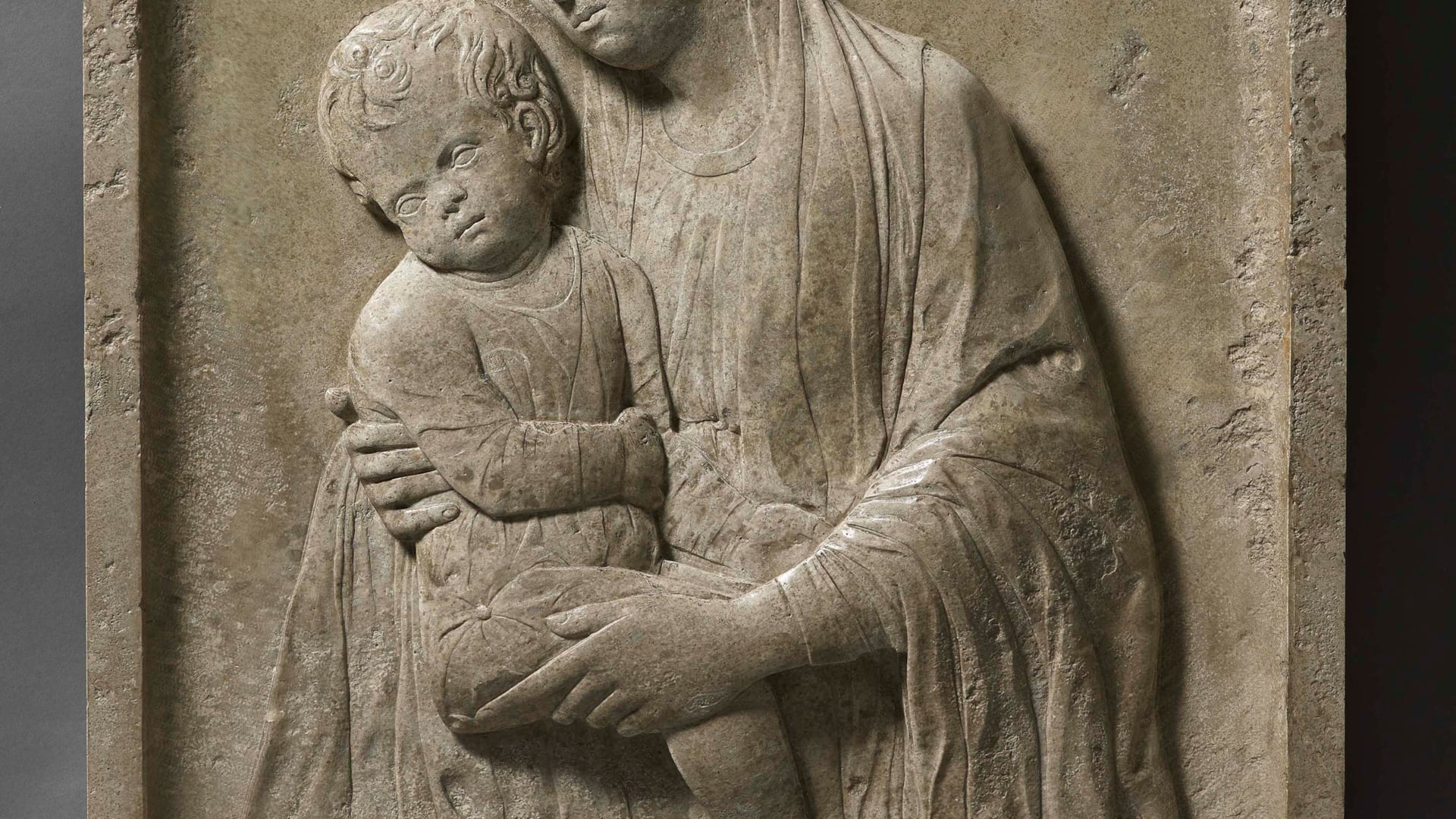

Private collection, Switzerland, from 2001
A. Markham Schulz, Antonio Rizzo. Sculptor and architect, Princeton, 1983
B. Boucher, ‘An enigmatic sculptor-architect’, Apollo Magazine, October 1984, pp.
B. Boucher, ‘An enigmatic sculptor-architect’, Apollo Magazine, October 1984, pp.
Reliefs representing the Virgin and Child are usually associated with the Florentine Renaissance and models by artists such as Ghiberti and Donatello. The present work differs from these by the treatment of its shallow relief, set off against the background, the rounded faces, sharply delineated lips and arched brows. These features are distinctive of a number of sculptures attributed to the enigmatic sculptor Antonio Rizzo.
In her extensive monograph on Rizzo, Markham Schulz supposes that he must have been in Florence yet in his review of the monograph Boucher suggests that the artist’s work is distinctly different from Florentine art. Rizzo’s vein of classicism could derive from the Venetian and Pavian schools, which also gave rise to artists such as Agostino di Duccio (1418-1481) with his distinctive linear style and Pietro Lombardo (1430-1515).
Rizzo was born in Verona in the 1430s. While little documentation exists about his life, it is known that he was active mainly in Venice between 1465 and 1498. His work includes the two marble statues of Adamand Eveon the further side of the Foscari Arch, opposite the Giants' Staircase, in the courtyard of the Doges' Palace in Venice. He also executed the tombs of Doge Niccolò Tron, in Santa Maria Gloriosa de' Frari; of Doge Antonio Barbarigo, in the church of the Carità (between 1483 and 1493); and of Giovanni Emo, in Santa Maria dei Servi (after 1483). At the end of his life he was forced to escape from Venice due to a financial scandal, an event that probably contributed to the fading of his reputation. The use of pietra di Nanto, a stone from the Veneto, corroborates the attribution to Rizzo who executed several sculptures and architectural works in local stone instead of marble, such as the Page holding a shield with a coat of arm formerly part of the tomb of Doge Giovanni Emo (Musée du Louvre, Paris).
In her monograph on Rizzo Markham Schulz published a somewhat heterogeneous group of four reliefs with the Virgin and Child (see lit., figs. 22, 29, 160 and 161). The only documented one (fig. 22), a high relief on the altar of Saint Clement in Saint Mark’s Basilica, shows affinity with the present sculpture: the full cheeks, the design of the hair line near the temples, the way of rendering the drapery, which is thicker on the arms than over the body and forms meandering lines as it falls towards the frame.
In her extensive monograph on Rizzo, Markham Schulz supposes that he must have been in Florence yet in his review of the monograph Boucher suggests that the artist’s work is distinctly different from Florentine art. Rizzo’s vein of classicism could derive from the Venetian and Pavian schools, which also gave rise to artists such as Agostino di Duccio (1418-1481) with his distinctive linear style and Pietro Lombardo (1430-1515).
Rizzo was born in Verona in the 1430s. While little documentation exists about his life, it is known that he was active mainly in Venice between 1465 and 1498. His work includes the two marble statues of Adamand Eveon the further side of the Foscari Arch, opposite the Giants' Staircase, in the courtyard of the Doges' Palace in Venice. He also executed the tombs of Doge Niccolò Tron, in Santa Maria Gloriosa de' Frari; of Doge Antonio Barbarigo, in the church of the Carità (between 1483 and 1493); and of Giovanni Emo, in Santa Maria dei Servi (after 1483). At the end of his life he was forced to escape from Venice due to a financial scandal, an event that probably contributed to the fading of his reputation. The use of pietra di Nanto, a stone from the Veneto, corroborates the attribution to Rizzo who executed several sculptures and architectural works in local stone instead of marble, such as the Page holding a shield with a coat of arm formerly part of the tomb of Doge Giovanni Emo (Musée du Louvre, Paris).
In her monograph on Rizzo Markham Schulz published a somewhat heterogeneous group of four reliefs with the Virgin and Child (see lit., figs. 22, 29, 160 and 161). The only documented one (fig. 22), a high relief on the altar of Saint Clement in Saint Mark’s Basilica, shows affinity with the present sculpture: the full cheeks, the design of the hair line near the temples, the way of rendering the drapery, which is thicker on the arms than over the body and forms meandering lines as it falls towards the frame.